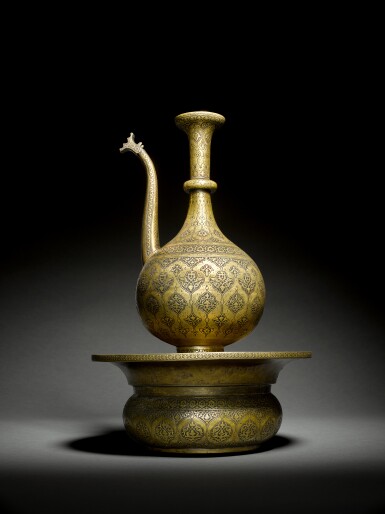Arts of the Islamic World and India
Arts of the Islamic World and India

A fine and rare large Safavid ewer and basin, Persia, 16th century
Auction Closed
April 24, 03:45 PM GMT
Estimate
180,000 - 220,000 GBP
Lot Details
Description
the ewer of pyriform shape on raised flared foot, the serpentine spout with dragon-head finial, the narrow waisted neck with bulbous ring and flanged terminal, engraved with repeated lobed cartouches containing arabesques, the basin of squat globular form supported on a short narrow foot with a broad flanged rim, the rim engraved with cartouches with inscriptions in nasta'liq, the interior with hinged openwork filter with pierced interlacing scrolls, the exterior engraved with cartouches filled with arabesques en suite with the ewer
ewer: 43.9cm. height
basin: 33.8cm. diam.; 14.6cm. height
Private collection, London, acquired July 1981
Of majestic proportions and bold engraving, this imposing and complete ewer and basin set is a magnificent example of Safavid metalwork of the late sixteenth century.
A ewer and basin of comparable, but slightly smaller, proportions were sold in these rooms, 6 October 2010, lot 199. The decorative repertoire of the two sets is comparably arranged with lobed panels of arabesques set against a plain ground. The basin of the 2010 example further displays comparable elongated eight-pointed star cartouches bearing ghazals of Hafiz around the rim. The engraving is, however, more extensive on the present lot given that it also covers the exterior of the basin, and the openwork filter comprises a comparably more elaborate and complex sea of entwined arabesques.
The form of the ewer is typical of the sixteenth century, and contemporaneous miniature paintings attest to the presence of such ewers in the Safavid courts. The basin, however, is more unusual. An example of comparable form with a globular body extending into a wide everted rim and attributed to 1580-90 is in the Victoria and Albert Museum (inv. no.952-1886, Melikian-Chirvani 1982, pp.302-3, no.133). Melikian-Chirvani suggests that it could have derived from Ming sources, though this is complicated by the cross-influence of Persian shapes on Chinese wares, or possibly derived from the earlier Khurasan tradition.
Many of the decorative motifs present here are a continuation of the iconographic repertoire of the Timurids. The dragon-headed spout and interlocked arabesque cartouches each feature in Timurid metalwork, although the tight configuration of the Timurid forebears has become more loosely rendered in the sixteenth century (Spink 2022, p.1211). The openwork technique is also frequently associated with Timurid bronze and Safavid steel (see lot 32 in the present sale). While the technique is necessarily functional in this basin, the arabesques bear resemblance to a late fifteenth or early sixteenth century brazier published in Pope 1938, pl.1379A, though more closely arranged in this example.
The configuration of lobed cartouches enclosing downturned arabesques features on a bath pail in the Victoria and Albert Museum attributed to the last quarter of the sixteenth century (inv. no.222-1892, Melikian-Chirvani 1982, pp.305-7, no.135). The contrast of the engraving against the plain ground is commanding, all the more for the majestic scale of the object. The decoration of the interior of the basin is comparably more dense than that of its exterior and ewer, the entirety of the surface being covered with poetic inscriptions and floral friezes. The juxtaposition of the two modes of decoration lends a sense of theatricality to the set as the ewer is lifted to reveal to the rich interior of the basin and the intricate scrollwork of the filter.
